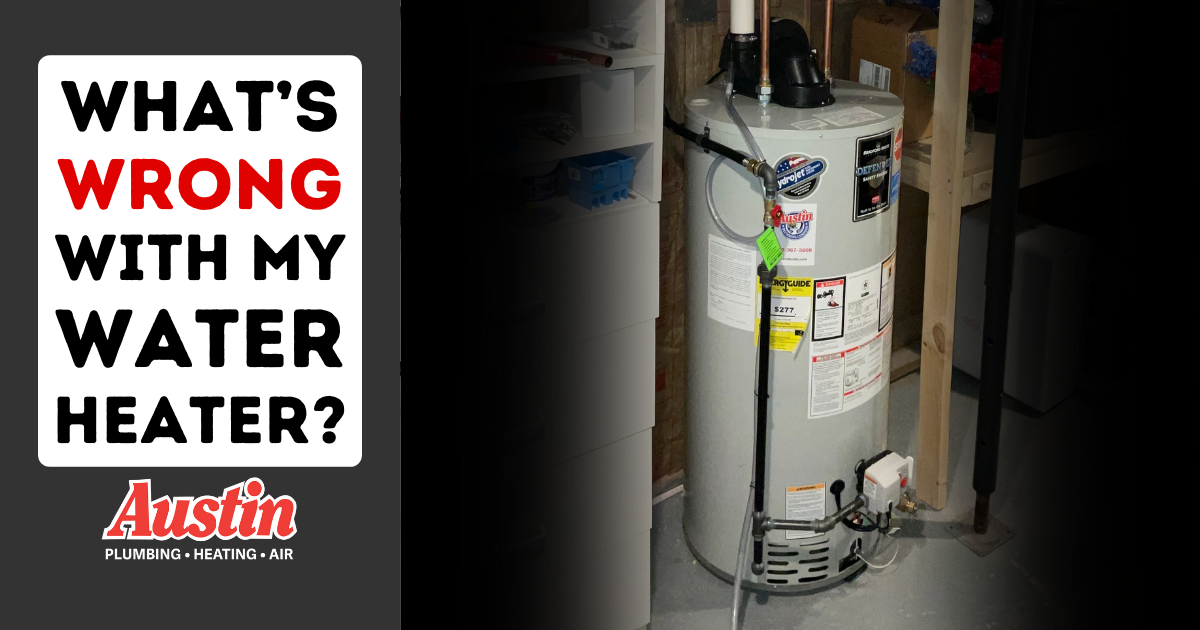Why Is My Water Heater Not Working? 10 Common Causes

Water heater not heating water? Our Master Tradesman delves into 10 possible reasons your water heater has stopped working.
Your water heater is one of the most important appliances in your home. It’s the singular source of hot water you need for showers, baths, dishes, and laundry–and it’s made to handle that level of daily usage. So if it suddenly stops working, there’s a reason.
Before You Begin
If you’re about to explore why your water heater has stopped functioning, please go about it safely. Electric water heaters are high-voltage appliances, and gas water heaters run on combustion. Both are dangerous to service–each one just has different risks associated with it! Do not attempt to troubleshoot your own water heater unless you are comfortable working with high-voltage electricity, natural gas, water, and exhaust.
Safety Precautions
Regardless of your experience level, you should not begin troubleshooting until you have taken the following precautions:
- Shut off the incoming gas to the water heater.
- Shut off the electricity to the water heater.
- Shut off the incoming cold water to the water heater.
- Make sure you have the correct electrical testing equipment.
- Make sure you have the proper tools.
- Be cautious of getting burned or scalded by hot metal or hot water as you proceed.
Now, let’s look at the 10 most common reasons for sudden water heater breakdown.
#1: No Power or No Fuel
To start off, it never hurts to check the most obvious possibility, which is that your water heater is either empty or disconnected from its power source.
- Electric water heaters: Make sure that the unit is plugged in. Then, double-check the circuit breaker to make sure it has not been tripped.
- Gas water heaters: Make sure that the gas valve is turned on–and that there is a decent supply of gas to the appliance!
#2: Thermostat Problem (No Continuity)
The thermostat is responsible for controlling the temperature of the water produced. If it can’t detect temperatures accurately, you’ll be unable to heat your water to the desired temperature. After turning off your water heater, you should:
- Remove the thermostat.
- Use a multimeter to test the thermostat for continuity.
No continuity means the thermostat will need to be replaced.
#3: Heating Element Problem
If you have an electric water heater, the heating element is the part responsible for making the water hot. When it malfunctions, you can imagine lukewarm water is often the result.
To check the heating element:
- Turn off the power to the water heater.
- Disconnect the two power wires that connect to the element.
- Use a multimeter to test the heating element.
The multimeter should be on the OHM setting, and it should give a reading between 12 and 13 ohms. Anything outside of that very tight range may indicate the electric heating element has failed, in which case you’ll need to replace it.
#4: Pilot Light Problem
For standard, gas-powered water heaters, the pilot is supposed to stay burning so that it can light the water heater whenever the thermostat calls for more hot water. The pilot light going out just happens to be the most common issue people encounter with classic water heaters.
The pilot light might go out during a windstorm, or because of an air bubble in the gas supply…or for several other reasons! It’s nothing to panic about. To relight the water heater pilot:
- Follow the instructions located in the water heater install manual, or…
- Follow the pilot re-lighting section of the water heater operations sticker. (This should be affixed to the tank of your water heater, where it can always be easily found.)
If you smell gas or are unable to light the pilot for any other reason, call Austin Plumbing, Heating & Air for service ASAP.
#5: Drain-Down Valve Problem
Located at the very bottom of the water heater tank, the drain valve is used to flush sediment and drain the water heater tank. When it fails, so will your water heater.
What’s nice is that there are really only a few ways for a drain-down valve to fail:
- The drain-down valve is clogged, preventing it from letting water out of the tank, or…
- The drain-down valve has a leak. If water from the drain valve leaks into the water heater’s burner compartment, that will not only cause the water heater to stop working, but it can also make it appear as though it’s leaking from the bottom of the tank!
Unfortunately, if you do find that the valve at the bottom of the water heater is leaking, it will likely need to be replaced. (Just be glad that it is not actually the tank that is the source of the leak–if it were, you’d need to replace the entire water heater!)
#6: Expansion Tank Problem
Expansion tanks minimize the expansion and contraction of the water heater as it undergoes temperature changes. These are required by code in many states, but optional (although highly recommended) in Wisconsin.
The job of the expansion tank is simple: absorb the outward pressure that builds up in your water heater. If the expansion tank fails and the bladder becomes waterlogged, it will cause other issues with the water heater, such as leaking pressure relief valves, water hammering, and (in extreme cases) water heater tank leakage, which is irreversible.
Troubleshooting an expansion tank consists of the following steps:
- Shut the water off to the heater.
- Turn off the gas or shut off the electrical power to the unit.
- Purge the pressure from the plumbing system ahead of the expansion tank.
- Check the air charge in the tank.
A properly working hot water expansion tank will have an air charge that is exactly equal to the home’s incoming water pressure. Any more or less and it will need to be replaced. Additionally, signs of cracks or leaks observable on the expansion tank mean you are looking at a high probability of needing to replace it.
#7: Overheating Problem
A water heater that gets excessively hot is a sign that the water heater isn’t working like it should. All water heaters have a built-in failsafe that kicks in when it gets too hot: it will either shut the water heater off, or it will begin expelling excess pressure from the tank.
For electric water heaters, the high limit is programmed into the water heater and is resettable. (This should also be checked if your electric water heater has gone from exceedingly hot to suddenly not hot at all.)
How to Reset the Temperature Maximum in an Electric Water Heater
- First, make sure the power to the water heater is totally off.
- Remove the water heater’s top access panel so that you can see both its thermostat and heating element.
- Find and press the red reset button located on the electric thermostat.
- If you feel the high-limit reset button depress and click, that’s a pretty good sign it had been tripped at some point before you examined it.
- Reassemble the top access cover.
- Turn the water heater’s power back on.
- Wait between 30 and 60 minutes. After that, if the water is successfully heating again, then your problem is solved!
- If the high limit keeps tripping after this, there is a deeper problem requiring professional diagnosis.
#8: Water Heater Leak
If your water heater isn’t working and you also notice a leak near (but not necessarily on) the tank, it’s safe to say you’ve found the source of your water woes. For next steps, see Troubleshooting Water Heater Leaks.
#9: The Age of Your Water Heater
In the end, sometimes a broken water heater simply comes down to old age.
Most water heaters demonstrate a useful lifespan of 10 years, with reported problems becoming increasingly frequent after the six-year mark. Joining our maintenance club is a cost-effective way to squeeze those final four years out without serious breakdowns cutting short the life of your water heater.
Of course, there’s a number of cases of water heaters outlasting the average 10-year prognosis.
If you’re really interested in beating the odds, see our comprehensive Water Heater Life Expectancy Guide to learn more.
#10: Damaged Appliance
Typically, “damage” implies that the water heater somehow got hurt before it was installed. That is not the kind of water heater damage we are talking about here. Here, we are referring to damage that accumulates after installation, such as water damage from tank leaks, plumbing leaks and backups.
There are also other major controls that, when damaged, may cause the water heater to fail. Surprisingly, these major components can unfortunately take damage from external sources. For example, we have seen electrical surges result in damaged gas valves, or snagged temperature relief valves begin to discharge.
But by far, the most common cause of post-installation damage to water heaters is excessively high water pressure. Water pressure above 80 PSI is just too much for a water heater to handle. It will constantly degrade the tank, which is the most important component of tank-style water heaters.
If you are experiencing the kind of damages discussed above, see our Emergency Water Heater Troubleshooting Guide or call Austin for help ASAP.
Avoiding Problems Before They Happen to Your Water Heater
Helpful Tips That Anybody Can Use to Prolong Their Water Heater’s Life
- Have your water heater serviced by a professional every year.
- Drain the water from your water heater every six months.
- Make sure your water softener is working properly, as it works in an interrelated manner with your water heater.
- Keep the water temperature set to a comfortable level that is safe for both your water heater and you!
- Any time you experience a power outage in your home, remember to turn off the power to your water heater. This will prevent a surge when the power comes back, at which point you can manually turn the water heater on again safely.
Still having trouble with your water heater? This isn’t an exhaustive list of problems, so your issue may not have been listed in this article. For the sake of your water heater, book an ASAP visit from Austin so we can diagnose the problem, explain our findings to you, and present options for repair or replacement.





